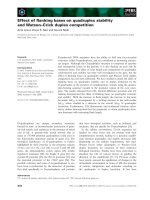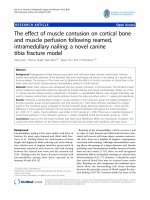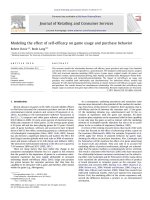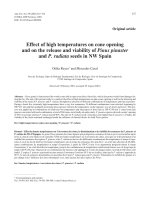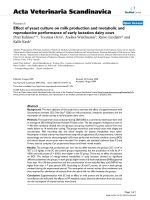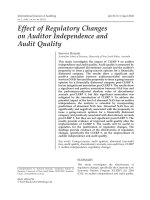Effect of phosphorus solubilizers on enzymatic activity and microbial parameters in the soil
Bạn đang xem bản rút gọn của tài liệu. Xem và tải ngay bản đầy đủ của tài liệu tại đây (553.67 KB, 13 trang )
Int.J.Curr.Microbiol.App.Sci (2019) 8(8): 2647-2659
International Journal of Current Microbiology and Applied Sciences
ISSN: 2319-7706 Volume 8 Number 08 (2019)
Journal homepage:
Original Research Article
/>
Effect of Phosphorus Solubilizers on Enzymatic Activity and
Microbial Parameters in the Soil
M. M. Sreelakshmi* and B. Aparna
Department of Soil Science and Agricultural Chemistry, Kerala Agricultural University,
College of Agriculture, Vellayani, Thiruvananthapuram – 695 522, India
*Corresponding author
ABSTRACT
Keywords
Phosphorus,
Microbial inoculants,
Dehydrogenase,
Acid phosphatase,
Alkaline phosphatase,
Urease, MBC,
MBP, MB C/P
Article Info
Accepted:
22 July 2019
Available Online:
10 August 2019
An experiment was carried out in the Department of Soil Science and Agricultural Chemistry,
College of Agriculture, Vellayani during 2017-18 in order to evaluate the effect of phosphate
solubilizers on the activity of different enzymes and microbial parameters in the soil and its impact
on crop growth and yield of test crop tomato var. Vellayani Vijai. The experiment was laid out in a
randomized block design with fourteen treatments and three replications. Treatments were the
combinations of four doses of P (100%, 75%, 50%, 25%) along with P solubilizers (AMF,
Pseudomonas, and Bacillus.). From the study, an increasing activity of dehydrogenase was observed
over a period of four months. At the harvesting stage, the highest value of 336.7 μg of TPF released
g-1 was observed in the treatment T3 (75% P +AMF). It was observed that the activities of acid and
alkaline phosphatase were significantly influenced by the treatment at 2, 3 and 4 MAP. An
increasing trend of acid phosphatase was observed up to 3MAP followed by a decline. At 4MAP, the
highest value of 59.89 μg of p-nitrophenol released g-1 of soil 24 h-1 was observed in T11 (PSB).
From the study, it was observed that the treatment did not impose any significant effect on the
activity of urease upto 3 MAP. However, an increasing trend of urease enzyme over a period of 4
months is noticed. The highest activity was noticed with the application of 50% P and AMF (69.45
ppm of urea hydrolysed g-1). Regarding MBC, the treatment T9 (25% P + AMF) registered the
highest value of 380 μg g-1 soil where the treatment T5 (50% P + PSB) recorded the highest MBP
content of 71.83 μg g-1 soil. The highest value for MB C/P was recorded by the treatment T14
(Absolute control) (14.28). Microbial load of P solubilisers was found to be high in the treatment T 5
(50% P + PSB) with average value of 3.60 log cfu g-1.
Introduction
Soil is a living system in which biological
activities takes place with the help of
enzymes. Enzymes are considered as
biological fingerprints and used as a measure
of mineralization and transportation of organic
carbon and the plant nutrients. They are
specific and have active sites that bind with
the substrate to form a temporary complex.
The enzymatic reaction releases a product,
which can be a nutrient contained in the
substrate. Dehydrogenase, acid phosphatase,
alkaline phosphatase and urease are major
enzymes influencing P availability and
organic matter decomposition.
Phosphatases are group of enzymes that
hydrolyzes phosphate groups from a wide
variety of organic substrates, producing
phosphate
ion
and
alcohol
(Tazisonget al., 2015). Acid phosphatases
2647
Int.J.Curr.Microbiol.App.Sci (2019) 8(8): 2647-2659
present in the rhizosphere plays a major role in
the mineralization of organic phosphorous
present in soil (Rodrıguez and Fraga., 1999).
Vuorinen and Aharinen (1996) reported that
the soil organic matter and acid phosphatase
are significantly correlated and the role of
phosphatase enzymes in the mineralizing
organic P esters in soils and rhizospheres is
vital. Casida (1997) reported that the
dehydrogenase enzyme is the best method for
measuring the metabolic activity of
microorganisms in soil. The activity of urease
was found to be high under consistent tillage
conditions (Jin et al., 2009). Larsenet al.
(2009) reported the increased levels of
dehydrogenase activity and available P in the
soils imposed with Glomus sp. Major research
effort is needed to consider the activity of
enzyme as a measure of soil biological
process.
Microbial inoculants play a great deal in
solubilizing the native P and increases various
fractions of available P. P-solubilizing
microorganisms (PSM) can solubilise and
mineralize P from inorganic and organic pools
of total soil P, and may be used as inoculants
to increase P-availability to plants. Soil
microbial properties were positively correlated
with the addition of nitrogen and/ phosphorus,
but responses of the soil microbial community
often varied depending on the quantity
nutrient added. These responses were more
significant for the combined additions of N
and P than single additions of either N or P.
Dong et al. (2015) reported that the
application of bio fertilisers increased the
population
of
bacteria,
fungi,
and
actinomycetes in soil. Debnathet al. (2015)
reported that there exists significant positive
correlation among microbial biomass carbon
(MBC), microbial biomass nitrogen (MBN)
and microbial biomass phosphorus (MBP).
In the present study, the activities of
dehydrogenase, urease, acid phosphatase and
alkaline phosphatase, microbial parameters
have been taken as the indices to access the
management induced changes.
Materials and Methods
An experiment was carried out in the
Department of Soil Science and Agricultural
Chemistry, College of Agriculture, Vellayani
during 2017-18. The study was envisaged to
evaluate the effect of phosphate solubilizers
on the solubility and availability of native
phosphorus and its impact on crop growth and
yield of test crop tomato var. Vellayani Vijai.
The experiment was laid out in a randomized
block design with fourteen treatments and
three replications. Treatments combinations
were imposed for assessing the effect of
Phosphorus solubilising microorganisms on
soil available P. Treatments were the
combinations of four doses of P along with P
solubilizers (AMF, Pseudomonas, and
Bacillus.).
The roots of tomato seedlings to be
transplanted in AMF treatment plots were
dipped in water slurry of AMF for 20 minutes
prior to transplanting. 2% PSB and
Pseudomonas were applied to respective plots.
The crop was raised as per the package of
practices
recommendations
of
Kerala
Agricultural University (KAU POP, 2016).
The soil samples were collected from
respective plots by random sampling
technique. They were dried in shade,
powdered with wooden mallet, sieved using 2
mm sieve and stored in polythene bags for
carrying out the analysis for physical,
chemical and biological parameters.
Results and Discussion
Dehydrogenase activity
Dehydrogenase is an extra cellular enzyme
capable of oxidizing the organic matter. It
reflects the total activity of micro flora and the
active cells present in the soil (Przepiora et al.,
2648
Int.J.Curr.Microbiol.App.Sci (2019) 8(8): 2647-2659
2016). From the study, it was observed that
the
activity
of
dehydrogenase
was
significantly influenced by the application of
the treatments (Table 2, Fig.1). In general,
there was an increasing activity of
dehydrogenase over a period of four months
(Table 2). This might be due to the increased
metabolic activity of microbial community
with subsequent increase in the organic matter
content. This is in conformity with the
findings of Deng et al., (2006). The increase
microbial activity may be attributed to the
mineral fertilization (N as urea, P as rajphos,
K as MOP) in conjunction with microbial P
solubilisers (Nakhro and Dkhar, 2010). This is
supported by higher microbial population of P
solubilisers in the treated plots with mean
values ranging from 3 to 3.6 log cfu g-1. A
positive correlation with microbial load
(r=0.355) was observed in the study (Table 8).
On further scrutiny of data generated, it is
observed that 75% P + AMF treated plots
recorded
the
highest
activity
for
dehydrogenase (Fig. 1) at 4MAP. The highest
MBC (366 μg g-1) recorded for this treatment
might be one of the possible reasons for
contributing the increased dehydrogenase
activity in this particular treatment. A
significant correlation with the crop yield (r=
0.836**) shows that the role of dehydrogenase
enzyme in maintaining the soil fertility cannot
be evicted. The lowest activity of
dehydrogenase reported in the control plot
might be due to consequence of lower levels
of organic carbon and microbial biomass
carbon.
Acid phosphatase and Alkaline phosphatase
Extracellular phosphor-mono-esterase (acid
phosphatase and alkaline phosphatase are
important enzymes involving P cycle of the
soil. From the data present in the Table 3,
Fig.2, it is observed that the activities of acid
and alkaline phosphatase were significantly
influenced by the treatment at 2, 3 and 4
MAP. In general, an increasing trend of acid
phosphatase was observed up to 3MAP
followed by a decline. The activity of acid
phosphatase was predominant over the
alkaline phosphatase. Similar results were also
reported by Lemnanowicz (2011). An inverse
relationship exists between soil acid
phosphatase status and the acid phosphatase
activity. This is supplemented by the
observation that the treatment with low
available P content reported the highest value
for acid phosphatase. The results are in
agreement with the findings of Bargaz et al.,
(2012).
On further scrutiny of the data, it is observed
that the effectiveness of the treatments were
non-significant on the activity of alkaline
phosphatase (Table 4, Fig 3). With respect to
acid phosphatase, the highest value reported in
the treatment T11 compared to other treatments
might be due to the inherent phosphatase
enzymes present in the cellwall of PSB and
also in the extra cellular polymeric substances
secreted by PSB (Behera et al., 2017).
Further from the study, it was observed that a
significant positive correlation existed
between acid phosphate and microbial load
(r=0.793**), alkaline phosphatase and
microbial load (r=0.545**). The role of Zn in
accelerating activity of acid phosphatase is yet
to be detailed as a significant positive
correlation between enzyme and Zn is noticed.
Comparatively lower values for available P in
this treatment might have induced the P status,
thereby resulting in production of alkaline
phosphatase by microbes using P signals
(Margalef et al., 2017). The soil pH values
were in the range of acidic for the acid
phosphatase enzyme and this is why this
enzyme did not significantly correlate with pH
(r=0.472). However, the alkaline phosphatase
exhibited a significant positive correlation
with pH (r=0.936**).
2649
Int.J.Curr.Microbiol.App.Sci (2019) 8(8): 2647-2659
Table.1 Treatment details
T1
T2
T3
T4
T5
T6
T7
T8
T9
T10
T11
T12
T13
T14
N,P & K as per KAU POP
75% P + Phosphate Solubilising Bacteria
75% P + Arbuscular Mycorrhizal Fungi
75% P + Pseudomonasfluorescens
50% P + Phosphate Solubilising Bacteria
50% P + Arbuscular Mycorrhizal Fungi
50% P + Pseudomonasfluorescens
25% P + Phosphate Solubilising Bacteria
25% P + Arbuscular Mycorrhizal Fungi
25% P + Pseudomonasfluorescens
Phosphate Solubilising Bacteria
Arbuscular Mycorrhizal Fungi
Pseudomonasfluorescens
Absolute control
*100% N & K were supplemented as per the KAU POP. The secondary, micronutrients and FYM were uniformly
applied to all plots except the control plot based on soil test values.
* Tomato variety: Vellayani Vijai
*PSB: Bacillus megaterium var. phosphaticum
Table.2 Effect of P solubilizers on Dehydrogenase activity in soil (μg of TPF released g-1soil h-1)
Treatments
1MAP
2MAP
3MAP
4MAP
T1 - N,P & K as per KAU POP
197.8
242.8
256.9
310
T2 - 75% P + PSB
194.7
252.9
278.9
315.9
T3- 75% P +AMF
193.8
205.8
240.9
336.7
T4- 75% P + P. flourscences
189.8
196.5
198.7
272.6
T5 - 50% P + PSB
192.5
225.8
230.5
235.4
T6 - 50% P + AMF
192.9
236.7
238
263.8
T7 - 50% P + P. flourscences
172.6
186
188
200.8
T8 - 25% P + PSB
190.5
195.2
215
225.9
T9 - 25% P + AMF
188.6
196.8
200.9
210.5
T10 - 25% P + P. flourscences
178.7
189.4
192.4
196.8
T11 – PSB
184.2
186
189.5
195.9
T12 - AMF
193.4
197.8
248.9
273.9
T13 - P. flourscences
189.9
194.5
197.8
210.5
T14- Absolute control
168.8
169.8
169
174.8
CD(0.05)
13.13
10.37
24.11
34.18
2650
Int.J.Curr.Microbiol.App.Sci (2019) 8(8): 2647-2659
Table.3 Effect of P solubilizers on Acid phosphatase activity
in soil (μg of p-nitrophenol released g-1 of soil 24 h-1)
Treatments
T1 - N,P & K as per KAU POP
T2 - 75% P + PSB
T3- 75% P +AMF
T4- 75% P + P. flourscences
T5 - 50% P + PSB
T6 - 50% P + AMF
T7 - 50% P + P. flourscences
T8 - 25% P + PSB
T9 - 25% P + AMF
T10 - 25% P + P. flourscences
T11 – PSB
T12 - AMF
T13 - P. flourscences
T14- Absolute control
CD(0.05)
1MAP
53.73
53.00
53.80
54.00
53.97
54.15
54.04
54.07
53.75
55.20
54.15
54.40
55.87
34.30
NS
2MAP
54.33
55.30
55.33
54.51
54.0
54.47
54.67
55.70
56.03
56.70
56.46
56.73
55.50
36.40
1.737
3MAP
55.63
54.09
56.76
54.03
53.80
57.53
59.13
60.17
59.52
56.00
61.80
59.20
57.80
38.90
3.037
4MAP
55.87
56.17
56.68
54.68
54.67
55.85
59.32
59.15
58.18
54.62
59.89
57.38
57.08
39.90
3.062
Table.4 Effect of P solubilizers on Alkaline phosphatase activity in soil (μg of p-nitrophenol
released g-1 of soil 24 h-1)
Treatments
T1 - N,P & K as per KAU POP
T2 - 75% P + PSB
T3- 75% P +AMF
T4- 75% P + P. flourscences
T5 - 50% P + PSB
T6 - 50% P + AMF
T7 - 50% P + P. flourscences
T8 - 25% P + PSB
T9 - 25% P + AMF
T10 - 25% P + P. flourscences
T11 – PSB
T12 - AMF
T13 - P. flourscences
T14- Absolute control
CD(0.05)
1 MAP
7.8
7.2
8.6
8.2
8.7
8.8
8.4
8.3
9.4
8.9
9.2
9.0
7.5
6.9
NS
2651
2 MAP
7.886
7.35
8.37
8.08
8.85
8.95
8.42
8.42
9.48
8.92
9.55
9.21
7.80
7.11
NS
3 MAP
7.72
7.25
8.63
8.23
8.76
8.90
8.46
8.41
9.42
9.10
9.21
9.00
7.60
6.95
NS
4 MAP
8.13
8.04
9.02
8.85
8.92
9.23
8.68
8.69
9.95
9.5
9.76
9.36
8.10
6.65
NS
Int.J.Curr.Microbiol.App.Sci (2019) 8(8): 2647-2659
Table.5 Effect of P solubilizers on Urease activity (ppm of urea hydrolysed g-1 of soil 24 h-1)
Treatments
T1 - N,P & K as per KAU POP
T2 - 75% P + PSB
T3- 75% P +AMF
T4- 75% P + P. flourscences
T5 - 50% P + PSB
T6 - 50% P + AMF
T7 - 50% P + P. flourscences
T8 - 25% P + PSB
T9 - 25% P + AMF
T10 - 25% P + P. flourscences
T11 – PSB
T12 - AMF
T13 - P. flourscences
T14- Absolute control
CD(0.05)
1MAP
52.91
57.32
54.82
53.1
54.1
51.94
52.82
50.7
51.55
53.74
49.93
50.27
50.46
49.81
NS
2MAP
58.47
59.32
61.81
60.79
59.2
59.31
56.23
55.18
55.83
55.44
56.97
57.77
54.21
52.15
NS
3MAP
62.52
60.73
63.24
62.43
61.21
60.73
60.77
57.73
59.81
58.15
58.14
60.17
57.92
52.81
NS
4MAP
66.43
66.11
68.72
67.57
66.36
69.45
64.5
62.98
63.74
60.79
60.88
62.35
58.73
53.41
5.208
Table.6 Effect of P solubilizers on Microbial biomass
Treatments
T1 - N,P & K as per KAU POP
T2 - 75% P + PSB
T3- 75% P +AMF
T4- 75% P + P. flourscences
T5 - 50% P + PSB
T6 - 50% P + AMF
T7 - 50% P + P. flourscences
T8 - 25% P + PSB
T9 - 25% P + AMF
T10 - 25% P + P. flourscences
T11 – PSB
T12 - AMF
T13 - P. flourscences
T14- Absolute control
CD(0.05)
MBC
(μg g-1 soil)
MBP
(μg g-1 soil)
Microbial
Biomass C/P
300
333
366
333
366
313
333
233
380
233
256
326
306
200
15.848
57.50
62.33
67.50
62.17
71.83
68.33
63.37
35.00
59.17
26.00
47.17
59.17
45.83
14.83
11.865
5.21
5.34
5.43
5.35
5.09
4.50
5.25
6.65
6.42
8.96
5.42
5.50
6.67
14.28
0.893
2652
Int.J.Curr.Microbiol.App.Sci (2019) 8(8): 2647-2659
Table.7 Effect of P solubilizers on Microbial load- P solubilizers
Treatments
Microbial Load - P
solubilizers (log cfu g-1 soil)
3.30
3.48
3.30
3.30
3.60
3.48
3.30
3.00
3.00
3.00
3.48
3.30
3.30
T1 - N,P & K as per KAU POP
T2 - 75% P + PSB
T3- 75% P +AMF
T4- 75% P + P. flourscences
T5 - 50% P + PSB
T6 - 50% P + AMF
T7 - 50% P + P. flourscences
T8 - 25% P + PSB
T9 - 25% P + AMF
T10 - 25% P + P. flourscences
T11 – PSB
T12 - AMF
T13 - P. flourscences
T14- Absolute control
CD(0.05)
3.00
0.122
Table.8 Correlation between Enzymatic activity, Microbial Load and yield
Dehydrogenase
Acid
Phosphatase
Alkaline
phosphatase
Urease
Microbial
Load
Dehydrogenase
1
Acid
Phosphatase
0.438
1
Alkaline
phosphatase
Urease
0.194
0.310
1
0.623**
0.590*
0.429
1
Microbial
Load
0.355
0.793**
0.545*
0.604*
1
Yield
0.836**
0.429
0.274
0.934**
0.502
2653
Yield
1
Int.J.Curr.Microbiol.App.Sci (2019) 8(8): 2647-2659
Fig.1 Effect of P solubilisers on the activity of Dehydrogenase enzyme
(μg of TPF released g-1 h-1)
Fig.2 Effect of P solubilisers on the activity of Acid phosphatase (μg of p-nitrophenol released g1
of soil 24 h-1)
2654
Int.J.Curr.Microbiol.App.Sci (2019) 8(8): 2647-2659
Fig.3 Effect of P solubilisers on the activity of Alkaline phosphatase (μg of p-nitrophenol
released g-1 h-1)
Fig.4 Effect of P solubilisers on the activity of Urease (ppm of urea hydrolysed g-1 h-1)
2655
Int.J.Curr.Microbiol.App.Sci (2019) 8(8): 2647-2659
Fig.5 Effect of P solubilisers on MBC, MBP
Urease
Microbial biomass carbon
Urease is a hydrolytic enzyme that is
responsible for the hydrolytic conversions of
urea to CO2 and NH3. Urease assay is
important in understanding the mineralization
process of N and its response to management
system (Klein and Klothis, 1980).
Microbial biomass carbon is the measure of C
contained within the living component of soil
organic matter. That is, bacteria and fungi
which decompose soil residue and organic
matter in the soil. Therefore microbial
biomass carbon is an easy indicator of
changes in total organic carbon content
(Anderson et al., 2013). On the scrutiny of the
data presented in the Table 6, Fig 5, the
treatment with the application of 25% P along
with AMF was similar with the application of
50%P and PSB. Increase in biomass carbon
might be due to the secretion of cellulolytic or
lignolytic enzymes which in turn might have
increased the microbial biomass carbon. Also
in the AMF treated plots, the sugars might
have been translocated from the roots through
hartig nets to the fungal mat, thus
accumulating in the soil in form of fungal
carbohydrates like triose, glycogen and
manitol which sugars are not readily
metabolized by the host plant, thus
contributing to higher amount of MBC
(Gosling et al., 2006).
From the study (Table 5), it was observed that
the treatment did not impose any significant
effect on the activity of urease upto 3 MAP.
However, an increasing trend of urease
enzyme over a period of 4 months is noticed.
The highest activity was noticed with the
application of 50% P and AMF (69.45 ppm of
urea hydrolysed g-1). The treatmental effect
was found to be similar with the application
of PSB, AMF and P. flourscences. The higher
organic matter content of 1.81% in this
treatment might have favoured the spurt of the
ureolytic bacteria resulting in hydrolysis and
release of enzyme (Lloyd and Sheaffe, 1973).
This is supported by a significant positive
correlation with the microbial load
(r=0.604**) and with yield (r=0.934**).
2656
Int.J.Curr.Microbiol.App.Sci (2019) 8(8): 2647-2659
Microbial biomass P
Soil Microbial biomass P is one of the most
labile forms of P in soil and plays a vital role
in biogeochemical cycling of P in soil. It can
be used as a tool to predict the P supplying
ability of soil and hence it act as biological
index of P (Chen et al., 2000). It is evident
from the data that, Microbial Biomass
Phosphorus
(MBP)
was
significantly
influenced by the application of P solubilisers.
The application of water soluble inorganic P
fertilizers along with P solubilisers (PSB,
AMF and P. flourscences) might have
enhanced the bio available pool of P which in
turns increased the root and rhizhospheric
microbiomes.
These microbes in turn can transform a small
fraction of available P to MBP. This might be
the reason for increase in MBP in P
solubiliser treated plots (Pradhan et al., 2017).
PSB was found to be superior for soil MBP
and microbial activity at optimum P levels
(Raghuveer et al., 2017). Similar effects on
microbial biomass P was also exhibited by
treatment involving AMF and P. flourscences.
Microbial biomass C: P ratio
In the present study, using these parameters
MBC and MBP, the C: P ratio was worked
out (Table 6). The highest value for C: P was
observed in the control plot (14.28). Similar
results were reported by Zhang et al., (2015)
who investigated on the C: P ratios in high P
soil. It is also evident from the study that
microorganisms compete with the plant roots
for the orthophosphate, and accumulate the
phosphorus making it temporarily unavailable
to crops. It can be also explained that the
inoculation of P solubilisers increase the
microbial biomass phosphate which might be
a reason for the reduction in MBC/P ratio in
soils treated with P solubilisers as observed
by Pradhan (2017). The variation observed in
the MBC/P ratio may be attributed to the
variation in microbial C and P in the
respective treatments.
Microorganisms are integral to soil P, P cycle
and as such play an important role in
mediating the availability of P to plants.
Utilization of microorganisms to increase the
availability of P in soil is therefore an
attractive preposition for developing a more
sustainable
agriculture.
Nonetheless
microorganisms are integrated to cycling soil
P and enhancement of localized microbial
activity in the rhizosphere as significant
implication for P nutrition for the plants
(Achal et al., 2007). It is evident from the
data present in the Table 7 that microbial P
solubilisers were significantly influenced by
the application of treatments. The highest
value of 3.60 log cfu kg-1 was observed with
50% P and PSB might be attributed to the
increased spurt in P solubilisers with the
balance supply of N,P,K fertilizers along with
solubilisers. A higher organic matter content
of 1.78% serves as the substrate for meeting
the C requirement of microbes and thus
resulting in a spurt. The acidic pH range of
the soil also supports the P solubilisers as it is
evident from the present study. The results are
in conformity with the findings of Gour and
Sachel (1980). AM symbiotic status changes
the chemical composition of root exudates
and the development of AM mycelium can act
as a C source for microbial community and
thereby resulting in an increase in the
rhizosphere micro biome (Aggarwal et al.,
2011).
The study concludes that there exists a
positive influence of P solubilisers on enzyme
activities and microbial population. The
activities of enzymes showed an increasing
trend and reached the maximum at the final
stage of crop growth. The treatments imposed
a significant effect on the microbial
parameters like MBC, MBP and microbial
load. Based on the study, it can be concluded
2657
Int.J.Curr.Microbiol.App.Sci (2019) 8(8): 2647-2659
that phosphorus dose can be reduced to 75%
P and its application along with AM Fungi
will improve enzyme activity and microbial
population.
References
Achal, V., Savant, V. V., and Reddy, S. M.
2007. Phosphate solubilization by a
wild type strain and UV-induced
mutants of Aspergillus tubingensis. Soil
Biol. Biochem. 39: 695-699.
Aggarwal, A., Kadian, N., Tanwar, A.,
Yadav, A., and Gupta, K. K. 2011. Role
of arbuscular mycorrhizal fungi (AMF)
in global sustainable development. J.
Appl. Nat. Sci. 3 (2): 340-351.
Anderson, N. P., Hart, J. M., Sullivan, D. M.,
Christensen, N. W., Horneck, D. A., and
Pirelli, G. J. 2013. Applying lime to
raise soil pH for crop production
(Western Oregon). Fertilizer and Lime
Materials Fertilizer Guide. 21.
Bargaz, A., Faghire, M., Abdi, N., Farissi, M.,
Sifi, B., Drevon, J., Ikbal, M. C., and
Ghoulam, C. 2012. Low soil
phosphorus availability increases acid
phosphatases activities and affects P
partitioning in nodules, seeds and
rhizosphere of Phaseolus vulgaris.
Agric.2: 139-153.
Behera, B. C., Yadav, H., Singh, S. K.,
Mishra, R. R., Sethi, B. K., Dutta, S. K.,
and Thatoi, H. N. 2017. Phosphate
solubilization and acid phosphatase
activity of Serratia sp. isolated from
mangrove soil of Mahanadi river delta,
Odisha, India. J. Genet. Eng.
Biotechnol. 17(5): 613-625.
Casida, L. E. 1977. Microbial metabolic
activity in soil as measured by
dehydrogenase determinationst. Appl.
Environ. Microbial. 34(6): 630-636.
Chen, G. C., He, Z. L., and Huang, C. Y.
2000. Microbial biomass phosphorus
and its significance in predicting
phosphorus availability in red soils.
Commun. Soil Sci. plant Anal. 31(6):
655-667.
Debnath, S., Patra, A. K., Ahmed, N., Kumar,
S., Dwivedi, B. S. 2015. Assessment of
microbial
biomass
and
enzyme
activities in soil under temperate fruit
crops in north western Himalayan
region. J. Soil Sci. Plant Nutri. 15 (4):
848-866.
Deng, S. P., Parham, J. A., Hattey, J. A., and
Babu, D. 2006. Animal manure and
anhydrous ammonia amendment alter
microbial carbon use efficiency,
microbial biomass, and activities of
dehydrogenase and amidohydrolases in
semiarid agroecosystems. Appl Soil
Ecol. 33: 258–268.
Dong, W. Y., Zhang, X. Y., Liu, X. Y., Fu, X.
L., Chen, F. S., Wang, H. M., Sun, X.
M., and Wen, X. F. 2015. Responses of
soil microbial communities and enzyme
activities to nitrogen and phosphorus
additions in chinese fir plantations of
subtropical China. Biogeosci. 12: 5537–
5546.
Gosling, P., Hodge, A., Goodlass, G., and
Bending, G. D. 2006. Arbuscular
mycorrhizal fungi and organic farming.
Agric. Ecosyst. Environ. 113: 17–35.
Gour, A. C. and Sacher, S. 1980. Effect of
rock
phosphate
and
glucose
concentration
on
phosphate
solubilisation by Aspergillus awamori.
Curr. Sci.49: 553-554.
Jin, K., Sleutel, S., Buchan, D., De Neve, S.,
Cai, D. X., Gabriels, D., Jin, J. Y. 2009.
Changes of soil enzyme activities under
different tillage practices in the Chinese
Loess Plateau. Soil and Tillage Res.
104: 115-120.
Klein, T. M. and Kloths, J. S. 1980. Urease,
protease and acid phosphatase in soils
continuously cropped to corn by
conventional or no-tillage methods. Soil
2658
Int.J.Curr.Microbiol.App.Sci (2019) 8(8): 2647-2659
Biol. Biochem. 12(6): 293-294.
Larsen, J., Cornejo, P., and Barea, J. M. 2009.
Interactions between the arbuscular
mycorrhizal fungus Glomus intraradices
and the plant growth promoting
rhizobacteria
Paenibacillus
polymyxaand P. maceransin the
mycorrhizosphere
of
Cucumis
sativus.Soil Biol. Biochem. 41: 286–
292.
Lemanowicz, J. 2011. Phosphatases activity
and plant available phosphorus in soil
under winter wheat (Triticum aestivum
L.) fertilized minerally Polish. J. Agron.
4: 12–15.
Lloyd, A. B. and Sheaffe, M. J. 1973. Urease
activity in soils. Plant and soil. Soil
Biol. Biochem. 39(1): 71-80.
Margalef, O., Sardans, J., FernandezMartínez, M., MolownyHoras, R.,
Janssens, I. A., Ciais, P., Goll, D.,
Richter, A., Obersteiner, M., Asensio,
D., and Penuelas, J. 2017. Global
patterns of phosphatase activity in
natural soils, Sci. Rep. 7(8): 1337-1345.
Nakhro, N. and Dkhar, M. S. 2010. Impact of
organic and inorganic fertilizers on
microbial populations and biomass
carbon in paddy field soil. J. Agron.
9(7): 102-110.
Pradhan, M., Sahoo, R. K., Pradhan, C.,
Tuteja, N., and Mohanty, S. 2017.
Contribution of native phosphorus
solubilising bacteria of acid soils on
phosphorus acquisition in peanut,
Protoplasma. 254(6): 2225-2236.
Przepiora, E. 2016. AM and DSE colonization
of invasive plants in urban habitat: a
study of Upper Silesia (southern
Poland). J. Plant Res. 129(4): 603-614.
Raghuveer, M., Ram, V., and Maurya, A. C.
2017. Impact of phosphorus levels and
PSB strains on soil microbial and
enzymatic activities under acidic soils
of
north
east
India.
Int.J.Curr.Microbiol.App.Sci.
6(6):
2061-2067.
Rodriguez, H. and Fraga, R. 1999. Phosphate
solubilizing bacteria and their role in
plant growth promotion. Biotechnol.
Adv. 17: 319–339.
Tazisong I. A., Senwo Z. N., He Z.
2015. Phosphatase hydrolysis of organic
phosphorus compounds. Adv. Enz.
Res. 3(2): 39–51.
Vuorinen, A. H. and Saharinen, M. H. 1996.
Effects of soil organic matter extracted
from soil on acid phosphomonoesterase.
Soil Biol. Biochem. 28(10 &11): 14771481.
Zhang, B., Li, S., Chen, S., Ren, T., Yang, Z.,
Zhao, H., Liang, Y., and Han, X. 2015.
Arbuscular mycorrhizal fungi regulate
soil respiration and its response to
precipitation change in a semi-arid
steppe. Spanish J. Soil Sci.4(5): 70-78.
How to cite this article:
Sreelakshmi M. M. and Aparna B. 2019. Effect of Phosphorus Solubilizers on Enzymatic
Activity and Microbial Parameters in the Soil. Int.J.Curr.Microbiol.App.Sci. 8(08): 2647-2659.
doi: />
2659
